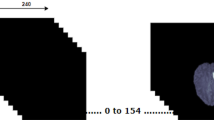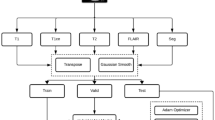Abstract
Segmentation of brain tumor from magnetic resonance imaging is a challenging and time-consuming task due to the unpredictable appearance of tumor tissue in practical applications. In this paper we propose a novel level-set-based model for tumor segmentation from multi-modality magnetic resonance imaging. We formulate the tumor segmentation on pixel-level with three classes: tumor, edema and healthy tissue. First, we detect abnormal regions by using a region-based active contour model on T2-weighted images with fluid-attenuated inversion recovery modality, and a variational level set formulation is applied locally to approximate the image intensities on two sides of the contour. In the second stage, we distinguish the edema and tumor tissues in the abnormal regions based on the contrast enhancement T1 modality. Compared with traditional one-modality methods, our model can better represent the specific tissue of tumor in a simple way. The validation experiments on synthetic and clinical brain magnetic resonance images demonstrate the effectiveness and simplicity of the proposed method for brain tumor segmentation.






Similar content being viewed by others
References
Bauer, S., Fejes, T., Slotboom, J., Wiest, R., Nolte, L.-P., & Reyes, M. (2012). Segmentation of brain tumor images based on integrated hierarchical classification and regularization. In MICCAI BraTS workshop. Nice: Miccai Society.
Bauer, S., Nolte, L.-P., & Reyes, M. (2011). Segmentation of brain tumor images based on atlas-registration combined with a markov-random-field lesion growth model. In IEEE international symposium on biomedical imaging: from nano to macro, 2011 (pp. 2018–2021). IEEE.
Chang, H.-H., & Valentino, D.J. (2008). An electrostatic deformable model for medical image segmentation. Computerized Medical Imaging and Graphics, 32(1), 22–35.
Clark, M.C., Hall, L.O., Goldgof, D.B., Velthuizen, R., Murtagh, F.R., & Silbiger, M.S. (1998). Automatic tumor segmentation using knowledge-based techniques. IEEE Transactions on Medical Imaging, 17(2), 187–201.
Dou, W., Ruan, S., Chen, Y., Bloyet, D., & Constans, J.-M. (2007). A framework of fuzzy information fusion for the segmentation of brain tumor tissues on mr images. Image and Vision Computing, 25(2), 164–171.
Gibbs, P., Buckley, D., Blackband, S., & Horsman, A. (1996). Tumour volume determination from mr images by morphological segmentation. Physics in Medicine and Biology, 41(11), 2437.
Hamamci, A., Kucuk, N., Karaman, K., Engin, K., & Unal, G. (2012). Tumor-cut: Segmentation of brain tumors on contrast enhanced mr images for radiosurgery applications. IEEE Transactions on Medical Imaging, 31(3), 790–804.
Khotanlou, H., Colliot, O., Atif, J., & Bloch, I. (2009). 3d brain tumor segmentation in mri using fuzzy classification, symmetry analysis and spatially constrained deformable models. Fuzzy Sets and Systems, 160(10), 1457–1473.
Kohler, B.A., Ward, E., McCarthy, B.J., Schymura, M.J., Ries, L.A., Eheman, C., Jemal, A., Anderson, R.N., Ajani, U.A., & Edwards, B.K. (2011). Annual report to the nation on the status of cancer, 1975–2007, featuring tumors of the brain and other nervous system. Journal of the National Cancer Institute, 103 (9), 714–736.
Li, C., Gore, J.C., & Davatzikos, C. (2014). Multiplicative intrinsic component optimization (mico) for mri bias field estimation and tissue segmentation. Magnetic Resonance Imaging, 32(7), 913–923.
Li, C., Kao, C.-Y., Gore, J., & Ding, Z. (2008). Minimization of region-scalable fitting energy for image segmentation. IEEE Transactions on Image Processing, 17(10), 1940– 1949.
Li, C., Xu, C., Anderson, A.W., & Gore, J.C. (2009). Mri tissue classification and bias field estimation based on coherent local intensity clustering: A unified energy minimization framework. In Information processing in medical imaging (pp. 288–299). Springer.
Li, C., Xu, C., Gui, C., & Fox, M. (2010). Distance regularized level set evolution and its application to image segmentation. IEEE Transactions on Image Processing, 19(12), 3243–3254.
Li, Y., Dou, Q., Yu, J., Jia, F., Qin, J., & Heng, P.-A. (2015). Automatic brain tumor segmentation from mr images via a multimodal sparse coding based probabilistic model. In International workshop on pattern recognition in neuroimaging (PRNI), 2015 (pp. 41–44). IEEE.
Nie, J., Xue, Z., Liu, T., Young, G.S., Setayesh, K., Guo, L., & Wong, S.T. (2009). Automated brain tumor segmentation using spatial accuracy-weighted hidden markov random field. Computerized Medical Imaging and Graphics, 33(6), 431– 441.
Rexilius, J., Hahn, H.K., Klein, J., Lentschig, M.G., & Peitgen, H.-O. (2007). Multispectral brain tumor segmentation based on histogram model adaptation. In Medical imaging (pp. 65140V–65140V). International Society for Optics and Photonics.
Shanthi, K., & Kumar, M.S. (2007). Skull stripping and automatic segmentation of brain mri using seed growth and threshold techniques. In 2007 International conference on intelligent and advanced systems.
Song, Y., Ji, Z., & Sun, Q. (2014). An extension gaussian mixture model for brain mri segmentation. In 36th annual international conference of the IEEE engineering in medicine and biology society (EMBC), 2014 (pp. 4711–4714). IEEE.
Song, Y., Wu, G., Sun, Q., Bahrami, K., Li, C., & Shen, D. (2015). Progressive label fusion framework for multi-atlas segmentation by dictionary evolution. In Medical image computing and computer-assisted intervention–MICCAI 2015 (pp. 190–197). Springer.
Stadlbauer, A., Moser, E., Gruber, S., Buslei, R., Nimsky, C., Fahlbusch, R., & Ganslandt, O. (2004). Improved delineation of brain tumors: an automated method for segmentation based on pathologic changes of 1 h-mrsi metabolites in gliomas. Neuroimage, 23(2), 454–461.
Subbanna, N., & Arbel, T. (2012). Probabilistic gabor and markov random fields segmentation of brain tumours in mri volumes. In Proceedings of MICCAI brain tumor segmentation challenge (BRATS) (pp. 28–31).
Thapaliya, K., Pyun, J.-Y., Park, C.-S., & Kwon, G.-R. (2013). Level set method with automatic selective local statistics for brain tumor segmentation in mr images. Computerized Medical Imaging and Graphics, 37(7), 522–537.
Xiao, Y., & Hu, J. (2012). Hierarchical random walker for multimodal brain tumor segmentation. In Proceedings of MICCAI-BRATS (pp. 36–40).
Zhao, L., Wu, W., & Corso, J.J. (2013). Semi-automatic brain tumor segmentation by constrained mrfs using structural trajectories. In Medical image computing and computer-assisted intervention–MICCAI 2013 (pp. 567–575). Springer.
Zheng, Y., Jeon, B., Xu, D., Wu, Q., & Zhang, H. (2015). Image segmentation by generalized hierarchical fuzzy c-means algorithm. Journal of Intelligent & Fuzzy Systems, 28(2), 961–973.
Zikic, D., Glocker, B., Konukoglu, E., Shotton, J., Criminisi, A., Ye, D., Demiralp, C., Thomas, O., Das, T., & Jena, R., et al. (2012). Context-sensitive classification forests for segmentation of brain tumor tissues. In Proceedings of MICCAI-BRATS.
Acknowledgment
This work was supported by the National Natural Science Foundation of China under Grant No. 61401209, the Natural Science Foundation of Jiangsu Province, China (Youth Fund Project) under Grant No. BK20140790, the Fundamental Research Funds for the Central Universities under Grant No. 30916011324, and China Postdoctoral Science Foundation under Grants No. 2014T70525 & No. 2013M531364.
Author information
Authors and Affiliations
Corresponding authors
Rights and permissions
About this article
Cite this article
Song, Y., Ji, Z., Sun, Q. et al. A Novel Brain Tumor Segmentation from Multi-Modality MRI via A Level-Set-Based Model. J Sign Process Syst 87, 249–257 (2017). https://doi.org/10.1007/s11265-016-1188-4
Received:
Revised:
Accepted:
Published:
Issue Date:
DOI: https://doi.org/10.1007/s11265-016-1188-4




